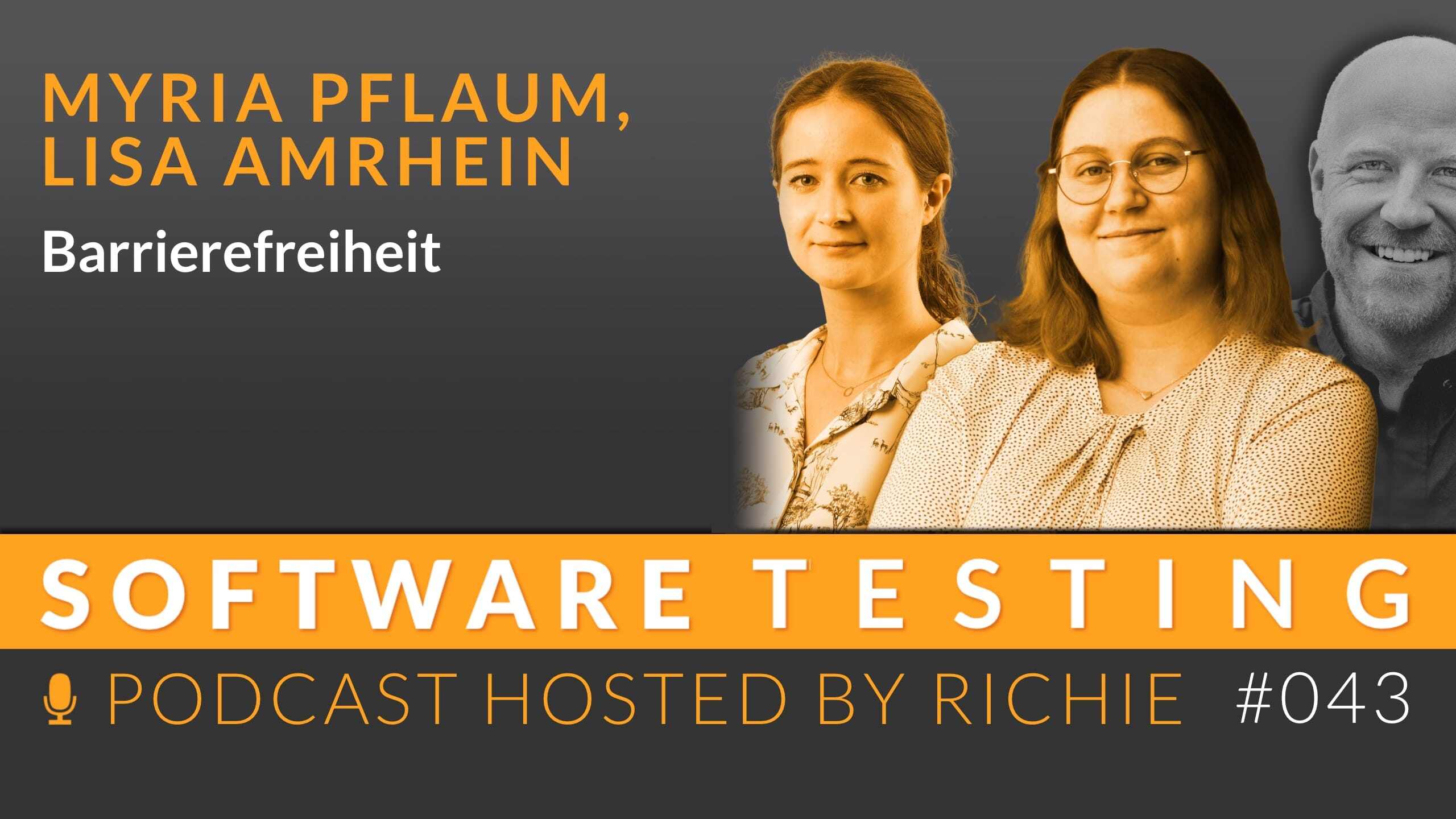Accessibility Tests
Podcast Episode: Accessibility Tests Accessibility in software development is not only a legal requirement, but also a sign of quality and user...

In this episode of the Software Testing Podcast, I talk to Rene Matthäi and Serdal Bilir about accessibility in software development. Serdal, who is visually impaired himself, shares his experiences and challenges with software. He explains how he helps developers develop accessible software by inviting them into his world and showing them how he works with Braille displays and screen readers. Rene emphasizes the importance of being involved early in the development process and establishing the right working modes. We also talk about the role of style guides and the need to use semantic elements correctly to ensure accessibility. Finally, we discuss the importance of accessibility being seen as an integral part of software development, not just a legal obligation.
"I'm blind myself, legally blind, I still have a very, very small visual test, I can still recognize outlines and light and dark, but I'm legally blind." - Serdal Bilir
After studying physics at TU Darmstadt, René Matthäi embarked on his journey along digitalization through companies and development teams, which is consistently quality-driven. Thanks to the extensive portfolio of his previous roles at Siemens and DATEV, he is familiar with a wide range of industries, where he was able to perform all functions related to software quality and the use of software.His interest in agile learning in groups, awareness of quality as a driver for speed and strategies for the hybrid integration of people, development models and technologies is expanding and he is pursuing this at the Federal Office for Migration and Refugees, as well as co-organizing the German Testing Day.
Serdal Bilir is a "Senior Consultant and Tester for Accessibility in Software Development" at the Federal Office for Migration and Refugees. He has been contributing his in-depth knowledge in the areas of accessibility and usability since 2017. After his training and valuable professional years at Evosoft GmbH, he specialized in accessibility testing and advises development teams to ensure accessible applications right from the start.
Accessibility is a key aspect of modern software development to ensure that digital products are accessible to all people, including those with disabilities. People with visual impairments, such as the legally blind, use aids such as screen readers or Braille displays to use software. Integrating their perspectives into the development process is essential to create accessible applications.
One of the biggest challenges in software projects is the late consideration of accessibility. The topic is often only addressed towards the end of the development process, which leads to considerable rework. In addition, there is often a lack of basic understanding of the requirements necessary for accessible software. Developers need to actively empathize with the needs of people with disabilities, which can be difficult without appropriate experience and training. Close collaboration between testers who specialize in accessibility and developers is crucial here.
Practical approaches and tools can be used to increase the awareness and competence of developers in the area of accessibility. Screen readers and Braille displays make it possible to directly experience the user experience of people with visual impairments. Open source tools such as NVDA (Non-Visual Desktop Access) offer a cost-effective and accessible way to take the first steps in this area. Such tools help developers to identify and eliminate potential barriers in their software.
Standards and reusability play a central role in the development of accessible software. Similar challenges are often solved multiple times in projects due to a lack of standardized components and style guides. The introduction of such standards ensures a consistent user experience and simultaneously increases efficiency in the development process.
The future of accessibility in software development is promising. The increased awareness of the importance of inclusive technologies, supported by laws and regulations, is making a significant contribution to improving the accessibility of digital products. At the same time, the intrinsic motivation of many companies to establish accessibility as an integral part of their processes is growing. Continuous training and awareness-raising measures are essential to ensure this progress is sustainable. These measures not only promote technical competence, but also an understanding of the needs of all users.
Accessibility is an important step towards an inclusive digital world. Early integration, the use of proven tools, standardized processes and regular training can ensure that software is accessible to all. With the right commitment and close collaboration between all stakeholders, barriers can be overcome and long-term improvements achieved.
An accessibility test is a method of ensuring that digital content such as websites, apps or documents are accessible to all users, including people with disabilities. It checks whether the content complies with guidelines such as the WCAG (Web Content Accessibility Guidelines).
An accessibility test is important to promote inclusion, meet legal requirements and create a better user experience for all. An accessible website increases reach and can increase user satisfaction.
Popular tools include Axe, Lighthouse, WAVE, NVDA (screen reader) and browser developer tools. They help to identify problems such as missing alternative texts, insufficient contrasts or incorrect keyboard navigation.
Common problems include missing alternative texts for images, insufficient color contrasts, unlabeled form elements, lack of keyboard operability and confusing navigation structures.
The WCAG (Web Content Accessibility Guidelines) in versions 2.0, 2.1 and 2.2 are the most important guidelines. They define standards for making content perceptible, operable, understandable and robust.
An accessibility test combines automatic tests with manual checks. Automatic tools identify basic problems, while manual tests check aspects such as keyboard navigation and screen reader compatibility.
Accessibility testing can be carried out by developers, UX designers and QA teams. External experts specializing in accessibility also offer comprehensive testing and consulting.
The costs vary depending on the scope and provider. A basic test can start at a few hundred euros, while comprehensive tests for large websites or apps can cost several thousand euros.
The duration depends on the complexity of the content to be tested. Small websites can be tested in a few hours, while large platforms can take days or weeks.
Accessibility improves the user experience, increases reach, reduces legal risks and strengthens brand reputation. It can also bring SEO benefits and tap into new target groups.
Companies benefit from an accessibility test by making their products and services accessible to all users. This increases customer satisfaction and expands the customer base, including people with disabilities. A successful accessibility test strengthens the brand image and demonstrates responsibility, which in turn promotes customer loyalty. It also helps to minimize legal risks and meets legal requirements. Overall, it increases competitiveness and enables better market access.
People with different disabilities should take part in an accessibility test, as they have direct experience of barriers. This includes people with visual, hearing or mobility impairments. Their feedback is essential to get a comprehensive picture of accessibility. Developers, designers and decision-makers should also be involved to ensure that digital and physical products are designed inclusively. An accessibility test is important to improve usability for all and meet legal requirements.
For an effective accessibility test, you should follow the steps below:
These steps will help to sustainably improve accessibility and ensure that all users have access.
The Web Content Accessibility Guidelines (WCAG) and the Accessibility for Ontarians with Disabilities Act (AODA) are crucial for effective accessibility testing. These guidelines provide clear standards to ensure that digital content is accessible to all users. In addition, the European Accessibility Act (EAA) can be used as another important standard. Compliance with these guidelines helps to break down barriers for people with disabilities and promote an inclusive user experience.
Common problems with accessibility testing are inadequate test methods that do not take all user needs into account. Automated tools that do not recognize all barriers are often used. Missing or unclear documentation can lead to important aspects being overlooked. Lack of involvement of people with disabilities during testing is also common. These factors can significantly reduce the effectiveness of the accessibility test and result in websites or applications not being accessible to all users.
An accessibility test ensures that websites and applications are accessible to all users, regardless of their abilities. It promotes usability and expands the target group, which leads to a higher number of visitors. It also minimizes legal risks, as many countries have legal requirements for accessibility. Ultimately, an accessibility test not only improves the user experience, but also demonstrates social responsibility and a commitment to inclusion.
The best tools for accessibility testing are Axe, WAVE and Lighthouse. Axe offers comprehensive analyses directly in the browser. WAVE enables a visual assessment of websites and highlights problems. Lighthouse is an integrated tool in Chrome that automatically performs accessibility tests and provides suggestions for improvement. Each of these tools supports developers in making websites more accessible and provides clear instructions on how to fix problems.
An accessibility test increases the accessibility of websites or applications for people with disabilities. The advantages are a broader user base, better user experience and legal security. The test is carried out in several steps: First, the target group is analyzed, then the test is carried out using special tools and methods. The results are then documented and recommendations for improvement are drawn up. Implementing these recommendations improves accessibility in the long term.
An accessibility test checks whether digital content is accessible to all people, especially people with disabilities. It includes checking website design, navigation, text alternatives for images and color contrasts. Such a test is important to ensure that every user has equal access to information, which fulfills legal requirements and increases user satisfaction. Identifying and removing barriers promotes inclusion and reaches a wider audience.
The W3C accessibility test assesses whether digital content is accessible to people with disabilities. The most important aspects are the perceptibility, usability, comprehensibility and robustness of the content. The test is carried out using technical tests, user feedback and a comparison with the Web Content Accessibility Guidelines (WCAG). For example, keyboard usability, screen reader compatibility and alternative texts for images are checked. The aim is to identify and eliminate barriers in order to ensure inclusive use.

Podcast Episode: Accessibility Tests Accessibility in software development is not only a legal requirement, but also a sign of quality and user...

Podcast Episode: When Customers are Colleagues Ada takes care of software quality at the ride-sharing company MOIA. The special thing about it is...

Podcast Episode: Accessibility Accessibility enables participation. Everyone knows the ramp for wheelchairs or the floor guidance systems for blind...